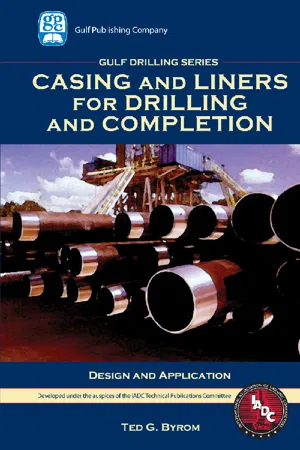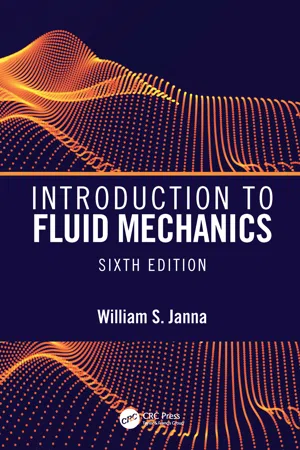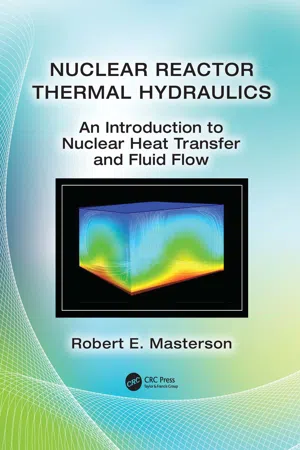Technology & Engineering
Hydrostatic Stress
Hydrostatic stress refers to the pressure exerted by a fluid at rest. It is uniform in all directions and increases with depth in the fluid. This type of stress is important in engineering and technology, particularly in the design and analysis of structures that are subjected to fluid pressure, such as dams, pipelines, and hydraulic systems.
Written by Perlego with AI-assistance
Related key terms
Related key terms
1 of 4
Related key terms
1 of 3
8 Key excerpts on "Hydrostatic Stress"
- Ahlam I. Shalaby(Author)
- 2018(Publication Date)
- CRC Press(Publisher)
Section 2.5 ). The measurement of the hydrostatic pressure at a point is important in the determination of the atmospheric pressure (barometers), the pressure at a point in a tank of fluid at rest (manometers), and the pressure at a point in a pipe flowing under pressure (manometers). The determination of the hydrostatic force acting on a submerged surface is important in the design of storage tanks, dams, gates, boats, ships, bulkheads, hydrometers, buoys, pipes, and hydraulic structures. The role of the hydrostatic force in the buoyancy and stability of a floating or a neutrally buoyant body is important in the design of balloons, ships, boats, submarines, and other floating bodies or neutrally buoyant bodies.2.2The Principles of HydrostaticsThe principles of hydrostatics are based on Pascal’s law and Newton’s second law of motion for fluid statics, which yield the hydrostatic pressure equation that represents the scalar ordinary differential equation of fluid statics. While Pascal’s law describes the hydrostatic pressure at a point, the hydrostatic pressure equation describes the variation of pressure from point to point. Application of the principles of hydrostatics requires the definition of the hydrostatic pressure, p ; the hydrostatic pressure head, h = p /γ ; and the hydrostatic pressure distribution for a fluid at rest. In order for a fluid element to be in static equilibrium (at rest), the sum of all of the external forces must be zero as given by Newton’s second law of motion:∑F = 0(2.1) The inertia force,FI= Ma = ρv 2 L 2 does not come into play in fluid statics. The significant forces acting on a fluid element at rest include those due to gravity,FG= Mg = W = γV and pressure,Fp= ΔpA . Furthermore, the viscous/shear force,Fv= τA = μ dv/dy does not exist in a fluid in static equilibrium, regardless of the fluid viscosity, μ . Therefore, for fluids at rest, there are only normal forces due to gravity and hydrostatic pressure (see Figure 2.1 ), while there are no shear forces due to viscosity. The gravitational force,FGacts normal through the center of gravity of the fluid element. The pressure force,Fpacts normal to the surface area of the fluid element, where the hydrostatic pressure, p- eBook - ePub
- Ron Darby, Raj P. Chhabra(Authors)
- 2016(Publication Date)
- CRC Press(Publisher)
4 Fluid Statics“Archimedes’ finding that the crown was of gold was a discovery; but he invented the method of determining the density of solids. Indeed, discoverers must generally be inventors; though inventors are not necessarily discoverers.”—William Ramsay, 1852–1916, ChemistI. STRESS AND PRESSUREThe forces that exist within a fluid at any point may arise from various sources. These include gravity, or the “weight” of the fluid, an imposed static pressure from an external source, an external driving force such as a pump or compressor, and the internal resistance to relative motion between fluid elements, or inertial effects resulting from the local velocity and the mass flow rate of the fluid (e.g., the transport or rate of change of momentum).Any or all of these forces may result in local stresses within the fluid. “Stress” can be thought of as a (local) “concentration of force,” or the local force per unit area that acts upon an infinitesimal volume of the fluid. Now both force and area are vectors, the direction of the area being defined by the normal vector that points outward relative to the fluid volume bounded by the surface. Thus, each stress component has a magnitude and two directions associated with it, that is, the direction of the force that acts on the fluid element, Fj , and the orientation of the surface of the element upon which the force acts, Ai. These are the characteristics of a “second-order tensor” or “dyad.” If the direction in which the local force acts is designated by subscript j (e.g., j = x, y, or z in Cartesian coordinates) and the orientation (i.e., the normal to the surface) of the local area element upon which it acts is designated by the subscript i, then the corresponding stress component (σij - Melvyn Kay(Author)
- 2017(Publication Date)
- CRC Press(Publisher)
Chapter 2Water standing still
Hydrostatics2.1 INTRODUCTION
Hydrostatics is the study of water when it is not moving; it is standing still. It is important to civil engineers who are designing water storage tanks and dams. They want to work out the forces that water creates in order to build reservoirs and dams that can resist them. Naval architects designing submarines want to understand and resist the pressures created when they go deep under the sea. The answers come from understanding hydrostatics. The science is simple both in concept and in practice. Indeed, the theory is well established and little has changed since Archimedes (287–212 BC ) worked it out over 2000 years ago.2.2 PRESSURE
The term pressure is used to describe the force that water exerts on each square metre of some object submerged in water, that is, force per unit area. It may be the bottom of a tank, the side of a dam, a ship or a submerged submarine. It is calculated as follows:pressure =Introducing the units of measurementforce area.pressure(=kN/m 2).force( kN )area(m 2)Force is in kilo-Newtons (kN), area is in square metres (m2 ) and so pressure is measured in kN/m2 . Sometimes pressure is measured in Pascals (Pa) in recognition of Blaise Pascal (1620–1662) who clarified much of modern day thinking about pressure and barometers for measuring atmospheric pressure.1 Pa = 1 N/m2 .One Pascal is a very small quantity and so kilo-Pascals are often used so that1 kPa = 1 kN/m2 .Although it is in order to use Pascals, kN/m2 is the measure of pressure that engineers tend to use and so this is used throughout this text (see example of calculating pressure in Box 2.1 ).2.3 FORCE AND PRESSURE ARE DIFFERENT
Force and pressure are terms that are often confused. The difference between them is best illustrated by an example:- eBook - ePub
- Ted G. Byrom(Author)
- 2013(Publication Date)
- Gulf Publishing Company(Publisher)
normal meaning perpendicular to the surface.2.3.1 Hydrostatic Pressure
Hydrostatic pressure is more or less intuitive. It might be described as a force per unit area exerted on a static fluid or by a static fluid on some material body. The hydrostatic pressure is a result of the body force plus any additional pressure that may be applied to the fluid. We also can write the fundamental equation of fluid statics in terms of pressure instead of body force. But, before we do that, it is necessary to introduce a coordinate system to make things a little easier. In almost all texts on mechanics, the coordinate systems used for illustration show the vertical coordinate to be positive in the upward direction, however since almost everything we measure in regard to a well in the oil field is measured from the surface downward, we start out with such a coordinate system and stay with it throughout this text. Figure 2-2 shows the coordinate system we most often use.Figure 2-2 An earth-oriented Cartesian coordinate system.Note that this is still a conventional right-hand coordinate system. It may look a bit awkward at first, because the positive z -axis points downward and the positive y -axis is to the right of the positive x -axis when viewed from above, but if viewed from below it is exactly what we are more accustomed to. The main advantage to us is that the z -axis is positive downward, so that our depth measurements in a well correspond in sign and direction to the z -axis. Another advantage to this coordinate system is that, if we assume the x -axis is positive in the North direction, then the y -axis is positive in the East direction, and directional azimuth and trigonometric functions are compatible since all angles are measured in the same direction. Directional azimuth in a well is measured from North in a clockwise direction, but trigonometric functions are such that the angle is measured counterclockwise from the x -axis towards the y - eBook - ePub
- Richard Gentle, Peter Edwards, William Bolton(Authors)
- 2001(Publication Date)
- Newnes(Publisher)
In the previous section we looked at the subject of hydrostatic pressure variation with depth in a liquid, and used the findings to explore the possibilities for measuring pressure with columns of liquids (manometry). In this section we are going to extend this study of hydrostatic pressure to the point where we can calculate the total force due to liquid pressure acting over a specified area. One of the main reasons that we study fluid mechanics in mechanical engineering is so that we can calculate the size of forces acting in a situation where liquids are employed. Knowledge of these forces is essential so that we can safely design a range of devices such as valves, pumps, fuel tanks and submersible housings. Although we shall not look at all the many different situations that can arise, it is vital that you understand the principles involved by studying a few of the most common applications.Hydraulics
The first thing to understand is the way that pressure is transmitted in fluids. Most of this is common sense but it is worthwhile spelling it out so that the most important features are made clear.Look at Figures 3.1.14 and 3.1.15 . In Figure 3.1.14 a short solid rod is being pushed down onto a solid block with a force F . The cross-sectional area of the rod is A and so a localized pressure ofFigure 3.1.14 Force applied to a solid blockFigure 3.1.15 Force applied to a liquidis felt underneath the base of the rod. This pressure will be experienced in the block mainly directly under the rod, but also to a much lesser extent in the small surrounding region. It will not be experienced in the rest of the solid block towards the sides.Now look at Figure 3.1.15 where the same rod is used as a piston to push down with the same force on a sealed container of liquid. The result is very different because the pressure ofwill now be experienced by all the liquid equally. If the container were to spring a leak we know that the liquid would spurt out normal to the surface that had the hole in it. If the leak were in the top surface of the container then the liquid would spurt upwards, in completely the opposite direction to the force that is being applied to the piston. This means that the liquid was being pushed in that upwards direction and that can only happen if the pressure acts normally to the inside surface. - Robert W. Fox, Alan T. McDonald, John W. Mitchell(Authors)
- 2020(Publication Date)
- Wiley(Publisher)
Although fluid statics problems are the simplest kind of fluid mechanics problems, this is not the only reason we will study them. The pressure generated within a static fluid is an important phenomenon in many practical situations. Using the principles of hydrostatics, we can compute forces on submerged objects, develop instruments for measuring pressures, and deduce properties of the atmosphere and oceans. The principles of hydrostatics also may be used to determine the forces developed by hydraulic systems in applications such as industrial presses or automobile brakes.In a static, homogeneous fluid, or in a fluid undergoing rigid‐body motion, a fluid particle retains its identity for all time, and fluid elements do not deform. We may apply Newton’s second law of motion to evaluate the forces acting on the particle.3.1 The Basic Equation of Fluid Statics
The first objective of this chapter is to obtain an equation for computing the pressure field in a static fluid. We will deduce what we already know from everyday experience, that the pressure increases with depth. To do this, we apply Newton’s second law to a differential fluid element of massd m = ρ d V, with sidesd x,d y, andd z, as shown in Fig. 3.1 . The fluid element is stationary relative to the stationary rectangular coordinate system shown.From our previous discussion, recall that two general types of forces may be applied to a fluid: body forces and surface forces. The only body force that must be considered in most engineering problems is due to gravity. We will not consider body forces caused by electric or magnetic fields.For a differential fluid element, the body force isd=F →Bg →d m =g →ρ d Vwhereg →is the local gravity vector, ρ is the density, andd Vis the volume of the element. In Cartesian coordinatesd V = d x d y d z, sod= ρF →Bg →d x d y d zIn a static fluid there are no shear stresses, so the only surface force is the pressure force. Pressure is a scalar field,p = pand in general we expect the pressure to vary with position within the fluid. The net pressure force that results from this variation can be found by summing the forces that act on the six faces of the fluid element.x , y , zLet the pressure be p at the center, O , of the element. To determine the pressure at each of the six faces of the element, we use a Taylor series expansion of the pressure about point O- eBook - ePub
- William S. Janna(Author)
- 2020(Publication Date)
- CRC Press(Publisher)
2 Fluid StaticsIn this chapter, we study the forces present in fluids at rest. Knowledge of force variations—or, more appropriately, pressure variations—in a static fluid is important to the engineer. Specific examples include water retained by a dam or bounded by a levee, gasoline in a tank truck, and accelerating fluid containers. In addition, fluid statics deals with the stability of floating bodies and submerged bodies and has applications in ship hull design and in determining load distributions for flat-bottomed barges. Thus, fluid statics concerns the forces that are present in fluids at rest, with applications to various practical problems.After completing this chapter, you should be able to:- Discuss pressure and pressure measurement;
- Apply the hydrostatic equation to manometers;
- Develop equations for calculating forces on submerged surfaces;
- Examine problems involving stability of partially or wholly submerged objects.
2.1 PRESSURE AND PRESSURE MEASUREMENT
Because our interest is in fluids at rest, let us determine the pressure at a point in a fluid at rest. Consider a wedge-shaped particle exposed on all sides to a fluid as illustrated in Figure 2.1a . Figure 2.1b is a free-body diagram of the particle cross section. The dimensions Δx , Δy , and Δz are small and tend to zero as the particle shrinks to a point. The only forces considered to be acting on the particle are due to pressure and gravity. On either of the three surfaces, the pressure force is F = pA . By applying Newton’s second law in the x - and z -directions, we get, respectively,FIGURE 2.1 A wedge-shaped particle.∑F x=p xΔ z Δ y −p sΔ s Δ y sin θ =ρ 2Δ x Δ y Δ za x= 0
where∑F z=p zΔ x Δ y −p sΔ s Δ y cos θ − ρ gΔ x Δ y Δ z2=ρ 2Δ x Δ y Δ za z= 0p x , p z , and p s are average pressures acting on the three corresponding facesa x and a z are the accelerationsρ is the particle densityThe net force equals zero in a static fluid. After simplification, with a x = az - eBook - ePub
Nuclear Reactor Thermal Hydraulics
An Introduction to Nuclear Heat Transfer and Fluid Flow
- Robert E. Masterson(Author)
- 2019(Publication Date)
- CRC Press(Publisher)
14Fluid Statics and Fluid Dynamics
14.1 Static Behavior of Fluids
Before we discuss how fluids behave in a reactor when the coolant pumps are turned on, we would first like to discuss how fluids behave when the coolant pumps are turned off. In a fresh core where there is no decay heat, the coolant can be considered to be stationary . The subject of how fluids behave when they are stationary is called fluid statics , and the study of how fluids behave when they are in motion is called fluid dynamics . Normally, the static behavior of fluids is easier to understand than the dynamic behavior because we do not have to track the motion of the fluid through the core. When a fluid is at rest, the forces acting on the fluid are balanced, and the pressure on a fluid molecule is the same in all directions. Classically, the pressure p is defined as the force that a fluid exerts on a unit surface normal or perpendicular to the applied force .Definition of the Pressure
p = Force/Area = F/A(14.1)In the SI system of units, the pressure is measured in N/m2 (Pa), and in the British system of units, it is measured in lb/in.2 (PSI). The pressure exerted by a fluid on a solid surface is shown in Figure 14.1 . Hydrostatics is the study of the forces that a fluid exerts on a submerged object such as a dam or a nuclear fuel rod.The hydrostatic force that has the greatest effect on the behavior of static fluids is gravity . Once the size of the gravitational acceleration is specified, the pressure at every point in a fluid becomes a function of depth. The product of the depth, the density, and the gravitational constant also give rise to buoyancy-induced forces , which are important during natural convection.FIGURE 14.1
Index pages curate the most relevant extracts from our library of academic textbooks. They’ve been created using an in-house natural language model (NLM), each adding context and meaning to key research topics.
Explore more topic indexes
Explore more topic indexes
1 of 6
Explore more topic indexes
1 of 4







